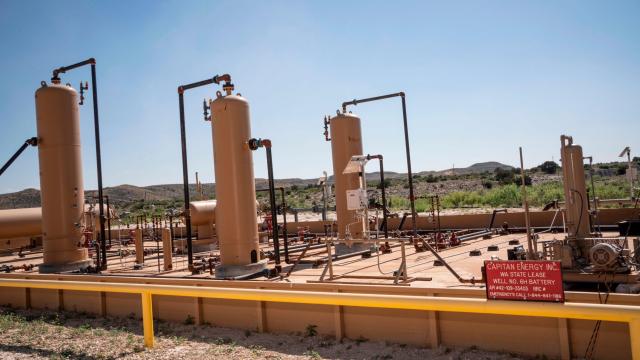In a mashup of two environmental dangers, fracking has been producing PFAS. For at least a decade, the U.S. Environmental Protection Agency has allowed oil companies to use certain chemicals for fracking, even though the agency knew they could degrade into PFAS — a group of highly toxic chemical compounds — over time.
Internal EPA documents, secured through a Freedom of Information Act and released by Physicians for Social Responsibility on Monday, show that in 2011 under U.S. President Barrack Obama, the agency greenlit the use of three chemicals known as P-11- 0091, P-11-0092, and P-11-0093. Each can help oil flow out of the ground more readily. The approval came despite the fact that the EPA itself had raised concerns about the substances’ effects on human health.
The findings suggest that between 2012 and 2020, the substances were used in more than 1,200 wells across Arkansas, Louisiana, Oklahoma, New Mexico, Texas, and Wyoming, based on the FracFocus database, which tracks chemicals used in fracking operations. Since not all states require companies to report which chemicals they use, the actual number of well where the toxic chemicals were used could be much higher.
Physicians for Social Responsibility also obtained a hazard assessment and consent order from the agency focused on the substances. Though both were heavily redacted, they make it clear that the agency doubted the compounds were safe.
“EPA has concerns that these degradation products will persist in the environment, could bioaccumulate or biomagnify, and could be toxic (PBT) to people, wild mammals, and birds based on data on analogue chemicals, including PFOA and [REDACTED],” EPA scientists wrote in the consent order, dated October 26, 2011. They also recommended further testing for the chemicals, but there is no evidence that any was done.
We’ve known that fracking is highly dangerous long before these revelations came to light. It produces harmful air pollution, including formaldehyde, which can cause cancer, and hydrogen sulfide, which can hurt cardiovascular and respiratory systems. According to numerous studies, it’s especially harmful to the poor communities who are forced to live near operations. Then there’s the climate impact; fracking produces methane, a greenhouse gas that’s 84 times more potent than carbon in the short term.
Still, the report lays bare new shocking risks. Among them, it shows that fracking comes with an additional risk for those working at drilling sites and living downstream from them. PFAS — chemicals that are found in everything from food packaging to electronics to the drinking water of 80 million Americans — have been linked to a vast array of health problems. Those issues include hormone disruption, high cholesterol, immune deficiency, and multiple kinds of cancer. PFAS are toxic even in very low concentrations, and they don’t easily break down in the human body or the environment, earning them the nickname “forever chemicals.” Yet the EPA had never made its approval of these three toxic fracking chemicals publicly known.
“The evidence that people could be unknowingly exposed to these extremely toxic chemicals through oil and gas operations is disturbing,” Dusty Horwitt, an attorney and researcher who co-authored the Physicians for Social Responsibility report, said in a statement. “Considering the terrible history of pollution associated with PFAS, EPA and state governments need to move quickly to ensure that the public knows where these chemicals have been used and is protected from their impacts.”
Approving these chemicals wasn’t the only way that the Obama-era EPA knowingly put people in danger from fracking. In 2013, DeSmog revealed that the agency killed a study that showed a clear link between fracking in Pennsylvania and groundwater contamination. Obama’s predecessor wasn’t exactly better; under former President Donald Trump, the EPA blocked a major report on PFAS and was extremely shady about working with members of Congress who represented districts with heavy PFAS burdens, including the Michigan district home to Flint.
There’s clearly a lot of work to do to restore the public’s trust and crack down on these toxic chemicals. The Biden administration has promised to tackle PFAS pollution. In the report, the authors outline some ways it could do so. The recommendations include further assessing the health effects of PFAS exposure, testing and tracking where PFAS was used in fossil fuel drilling to see if nearby soils and groundwater are contaminated, and forcing oil and gas and chemical firms to fund comprehensive cleanup. The group also calls for the government to require full public disclosure of what chemicals will be used at oil and gas wells before they can even be developed and for a moratorium on PFAS and chemicals that can break down into PFAS by fossil fuel companies.
Of course, the government should also just phase out fracking and other forms of fossil fuel extraction altogether, and quickly, to avert climate catastrophe. We didn’t really need another reason to do so, but now we’ve got one.
